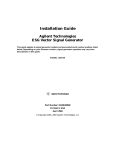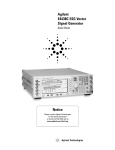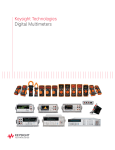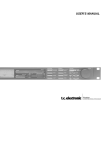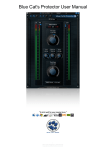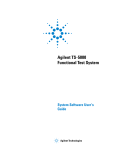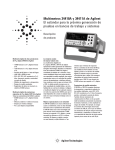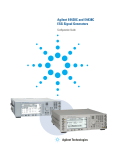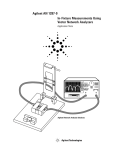Download Agilent Technologies 34411A Specifications
Transcript
Agilent 34410A/34411A 6 1/2 Digit High-Performance Multimeters Application Note Contents Introduction 1 Features and Performance 2 Applications and Solutions 4 Understanding Fast Measurements 13 The Advantages of a Built-In Web Server 18 Conclusion 19 Glossary 19 Introduction The Agilent 34410A and 34411A are the latest generation of 6 1/2 digit multimeters from Agilent Technologies. The 34410A and 34411A are general-purpose DMMs that give excellent price/ performance in a wide range of applications. Each DMM builds upon the success of the industrystandard Agilent 34401A, and each offers significantly enhanced functionality for bench and system users. Whether your application is in electronic components, aerospace, communications, automotive, industrial, or one of the many other industries that require DC and AC measurements, you will find that the 34410A and 34411A DMMs offer you the performance you need and are easy to use. This application note gives you a detailed look at how you can use the features and performance of these new DMMs in a variety of applications to overcome measurement challenges. Key features: Agilent 34410A 6 1/2 digit high-performance DMM • 10,000 readings/s at 51/2 digits • 1,000 readings/s at 61/2 digits • 30 PPM 1-year basic DC accuracy • LAN, USB and GPIB standard • DCV, ACV, DCI, ACI, 2/4-wire ohms • Frequency, period, continuity, and diode test • Capacitance and temperature measurements • Wide measurement ranges • Data logger with 50-k reading non-volatile memory Agilent 34411A 6 1/2 digit enhanced-performance DMM All the features of the 34410A, plus: • 50,000 readings/s at 41/2 digits • 1-million-reading memory • Analog level triggering • Programmable pre/post triggering The 34410A and 34411A are backward compatible with the Agilent 34401A multimeter and support a 34401A emulation mode. You will find a detailed comparison of the 34401A with the new 34410A/ 34411A DMMs in Application Note 5989-4038EN, “Replacing the Agilent 34401A with the New Agilent 34410A and 34411A High-Performance Digital Multimeters.” A number of performance specifications are called out in this application note; however, please refer to the 34410A/34411A multimeter data sheet, publication number 5989-3738EN, for specifics on overall measurement and system performance. Overview of Features and Performance Both the 34410A and 34411A are excellent bench-top and system DMMs. They are designed to be the best of both worlds and provide a very consistent path from the R&D bench environment into design validation and manufacturing. Key features for bench-top testing As bench DMMs, the 34410A and 34411A provide expanded R&D characterization functions and features: • Small bench-top foot print • Easy-to-use interface • Dual displays for setup and measurements • Enhanced probe kit for surface-mount parts • DCV, DCI, ACV, ACI, Freq/Period, 2/4 wire • Diode testing and continuity • Precision capacitance measurements • Offset-compensated resistance measurements • Temperature measurements (thermistor and RTD) • Peak measurements while measuring DC or AC signals • Statistical math at maximum sample rate • Limit checking with analoglike status on display • Simple data logging to non-volatile memory • Built-in Web server • Intuilink software for Excel spread sheets 2 In today’s electronic world, surface-mount resistors and capacitors are very small and unmarked. If you have a DMM with a high-quality set of surface-mount probes, you can make precision capacitance measurements which will help you re-categorize that pile of parts lying on your bench. Peak measurements while performing precision DC or AC measurements is a significant troubleshooting tool. The built-in data logging wizard allows you to pick any function, set up the timing, and let the DMM make unattended measurements while storing them into non-volatile memory. With a LAN connection to your PC, the built-in Web server makes it easy to cut and paste readings directly into your spread sheet, or you can use the supplied IntuiLink software for simple data logging from USB, LAN, or GPIB. • Hardware handshake to switch instruments • Precision sample timer for waveform capture • Peak measurements while measuring DC or AC signals • 100-Mbit LAN, USB 2.0, and GPIB • Web server for remote access • LXI Class C compliant • 34401A emulation mode • Drivers for IVI and LabVIEWTM Key features for system use Remove the rubber bumpers and handle, and you have a system-ready DMM that can outperform even VXI and PXI instrumentation. You get higher throughput in high-volume manufacturing for applications such as wireless handsets, wireless LAN, Bluetooth, and automotive testing. Key features for the system user: • Front and rear input terminals • Easy-to-use SCPI command language • Up to 50 k readings/s, continuous to PC • Traceable accuracy in addition to fast measurements • Retrieve readings up to 270,000/s from reading storage • Sub-millisecond command parsing • Sub-microsecond external trigger latencies These DMMs are system ready – you turn them on, and they’re ready for operation from the front panel or through a Web browser. You don’t have to install drivers before you can even use the instrument. Having a built-in Web server gives you complete control of the DMM from any computer that has a LAN port. If you can connect to eBay.com, you can connect to these DMMs without the need for any driver software. Developing programs is almost as easy. The DMMs come with Agilent’s powerful VISA I/O library, drivers, and examples for the most popular programming development environments, so you are programming within minutes, not hours. 3 If you are considering replacing the 34401A in your test system, all you need to do is put the 34410A or 34411A in emulation mode using the “SYSTem:LANGuage 34401A” command. You do not have to rewrite your tests – except to compensate for a much faster instrument and higher-resolution measurements. This mode is retained in nonvolatile memory, so when you cycle power, the DMM still thinks it is a 34401A. Please refer to Application Note 5989-4038EN, “Replacing the Agilent 34401A with the new Agilent 34410A and 34411A High-Performance Digital Multimeters.” Applications and Solutions Whether your application requires general-purpose measurements, precision DC and AC measurements, waveform capture of mechanicalelectrical signals, or fast throughput and programming speed, these new DMMs have the measurement capability you need. This section gives you examples that demonstrate some of the newer capabilities not found in many generalpurpose DMMs. The next section, “Understanding Fast Measurements,” will show you how to configure your DMM for these measurements. Precision measurements with high NMR The 34410A and 34411A use a special aperture-shaping algorithm to increase normal mode rejection (NMR) of power-line-related noise in DC measurements. It is an increasing and decreasing series of weighted averages of multiple measurements. This special algorithm is utilized on NPLC settings of 2, 10, and 100. At 1 PLC, the NMR is specified as 55 dB, but at 2 PLC, the rejection leaps to 110 dB at ±0.1% of the power line frequency. Most DMMs provide only 60 dB of rejection at 10 and 100 NPLC settings and ±0.1% of deviation from line frequency. However, the shaped aperture algorithm creates a wider notch of operating frequency and achieves 75 dB at ±1% and 55 dB at ±3%. This allows higherprecision measurements at faster rates than is available from most other DMMs on the market. Precision capacitance measurements When you are designing circuits, it is highly advantageous to know the actual value of a capacitor to be used in a circuit. Hand-held multimeters and most 51/2 digit multimeters typically use a measurement technique that assumes an ideal capacitor being charged by an ideal constant current source to determine capacitance with the formula C = I/(dV/dt). These instruments then specify an error of 1% or more for film capacitors (polyester and polypropylene dielectrics) but do not specify errors for capacitors of other dielectrics. 4 Real-world capacitors exhibit non-ideal behavior due to dielectric absorption, leakage, dissipation factor, and nonlinear equivalent series resistance (ESR). Current sources are not ideal either, so a substantial amount of error can be introduced using this time-domain, straight-line approximation technique. The 34410A and 34411A use a patented, time-domain algorithm to reject some of the non-ideal performance characteristics of capacitors. First and foremost, the A-to-D is able to sample fast enough to capture multiple points on the charge ramp of the capacitor under test without introducing significant noise to the measurement. Second, the constant current source does not have substantial non-ideal behaviors such as a thermal tail when turning on. Third, the internal capacitance of the DMM and lead capacitance of the probes can be calibrated out using the built-in math null function, which subtracts the initial measurement from all subsequent measurements. Substantial improvements in accuracy are attained using this technique. The 34410A and 34411A DMMs can actually perform much better than their 0.5% specifications. In lab testing on a high-accuracy capacitance standard, these DMMs achieved a performance level on the order of 0.1%. Furthermore, measurements of capacitors with poor dielectrics, such as aluminumelectrolytic capacitors, showed greatly improved accuracy. Simple data logging without a PC Let’s say your boss stops by just before you leave for lunch and asks you to measure temperature changes in the computer server room. He suspects the air conditioner is generating rapid and wide changes in temperature. How can you get this started quickly and still meet your lunch date on time? • Grab your 34410A, probe, and power cord and bring them to the computer room • Position the sensor probe • Select the temperature measurement function and sensor type • Press the Data Log key and set up 1-second intervals for an hour • Press the Trigger key to start the process • Go to lunch When you return from lunch, the measurements are complete. Or, if an hour has not passed, you can stop the data logging process by pressing any key for a prompt. Either way, your readings are stored in non-volatile memory. Now finish up: • Unplug the DMM and carry it back to your office • Hook up the LAN and start your PC’s browser • Cut and paste readings from the browser into your spread sheet • Print out the chart or graph, and submit it to your boss 5 Key points: • You did not have to drag a computer along to set up measurements. • Set up was very easy from the front panel. • The 34410A is small and easily transportable. • You did not need to write or load a program to gather the data. Precision DCV measurements combined with peak measurements Power supplies often have ripple voltages that are riding on top of the desired DC output. These ripple voltages are specified and tested to be a certain level or less. Frequencies of the AC signal are often power-line related, but they can be associated with higher-frequency byproducts of switching power supplies. For example, Figure 1 shows a DC signal with an AC component. A common approach to this measurement problem is to make both a DCV and ACV RMS measurement. However, there are limitations to this approach: • Making two measurements takes more time – especially changing function and range. • A typical ACV RMS measurement lacks valuable peak information. • Having to digitize to get peak information takes time. 5 VDC Figure 1. A 5 V DC signal with an AC signal The 34410A and 34411A DMMs provide a secondary measurement function called peak measurements that you can activate when you make precision DCV (or ACV) measurements. Here is an improvement on the above approach: • Enable the peak measurement function. • Make a precision DCV measurement using 1 or more periods of power-line cycle integration time to reject power line frequencies and random noise. • The DCV and peak measurement data is displayed. Peak measurements occur at 20-µs intervals during the aperture of the DCV measurement, so any peak that is at least 20 µs wide can be detected. 6 Several scenarios that can be determined from the two measurements: 1. The DCV and peak-to-peak data are within tolerance – passed 2. The DCV is correct, but the peak-to-peak value exceeds a limit – failed 3. The DCV is slightly off, but the peak-to-peak value is OK – failed In cases 2 and 3, the peak-to-peak ripple voltage is in question. Case 2 may be excessive noise spikes due to failed output filtering. Case 3 could be distortion that is creating an asymmetrical AC component that adds a DC component to the DCV measurement. In that case, the ripple may retain the same peak-to-peak voltage. When the primary measurement fails, more information about the signal is required. The 34411A DMM provides waveform capture at 50 k readings/s that can sample the signal to provide additional diagnostic information. In manufacturing, the goal is to minimize test time, so the combination of precision DCV and peak measurements can significantly reduce test time compared to making individual DCV and ACV measurements or digitizing and processing the signal. The additional benefit is obtaining the peak-to-peak information which can better indicate the quality of the power supply’s output signal. Precision measurements with level triggering The following waveform (Figure 2) represents the current drain of a battery during an operation in a hand-held device. The goal is to measure the average DC value of the pulse, but only during the duration of the pulse. This pulse has no associated 5-V logic signal event that can be used as a synchronous external trigger. At first, it would seem that capturing the asynchronous event with a large number of high-speed measurements – followed by processing the waveform in a computer to come up with the result – would be the only solution. This is a relatively simple measurement to make for a DMM that has analog level triggering. No external TTL-pulse is needed to start the measurement. The 34411A is set to trigger at some point on the rising edge of the pulse (a percent of range). A trigger delay can be used to make sure the measurement starts on the “flat” portion of the pulse, and the A-to-D aperture is set to a value that maximizes the precision of the measurement without exceeding Trig Delay 100 µs the duration of the pulse width. In the example, a 100-µs delay from the level trigger will place the beginning of the measurement past the rising edge. Using a 1-ms aperture, the 34411A can make a 6 1/2 digit measurement. In addition, any DC measurement allows the use of the peak measurement function to capture the peakto-peak content, as shown in the previous example. 1 ms aperture Average DC Pk-Pk Level Trigger Starts Measurement Figure 2. Peak detect occurs at 20-µs intervals over the duration of the measurement aperture 7 Testing fluorescent ballasts using direct-sampled ACV When a fluorescent lamp is off, the mercury/gas mixture within the tube is non-conductive. When power is first applied, 300 VAC is needed to initiate a gas discharge of mercury radiation. The electric current passing through the low-pressure gas emits UV light. The internal phosphor coating efficiently converts most of the U V to visible light. Once the initial discharge takes place, a much lower voltage – usually a voltage from 100 VAC to 175 VAC – is needed to maintain the discharge, dependent upon the wattage rating of the bulb. A DMM is needed to test the ballast voltages to assure the correct voltages are being applied. This is an ACV measurement. Many DMMs, including the Agilent 34401A, use an analog RMS converter for ACV measurements. Although these converters can measure frequency content as high as 1 MHz, they do not do a very good job of telling the DMM that short-duration, highvoltage spikes may be present on the input. These short spikes may have little impact on RMS content, so the resulting voltage measurement may hardly deviate from the expected voltage. Initial Discharge – 300 VAC Steady State – 100 VAC Figure 3. Ballast voltage needed to start a fluorescent bulb and then keep it lit For example, the ballast may actually generate 1-kV or higher spikes along with the 300-VAC signal needed for initial startup. The DMM may read 300 VAC and occasionally 301 VAC. The test system thinks that is just fine – well within tolerance. However, you do not see the huge voltage spikes pounding against the input section of the DMM. If the DMM does not have effective input protection, the input circuitry can eventually fail after continued abuse. The 34410A and 34411A use a direct sampling technique to make AC RMS measurements. Relative to analog RMS calculations, the direct sampling technique offers four primary advantages: 10-times faster AC measurements, improved accuracy for high-frequency sinusoids, peak-to-peak information, and no crest factor de-rating. 8 Significant over-sampling of the input signal can detect the narrow, high-voltage spikes, and the DMM can then respond to those spikes with an overload error condition. This informs the test engineer that a problem exists either in the wiring connections to the DMM or in the ballast. The solution can be as simple as adding filtering in the fixture to suppress expected spikes before arriving at the input terminals of the DMM. Either way, the test engineer is better informed by a DMM that can “see” that actual content of the signal. Direct-sampled AC provides that visibility into signal content, so both RMS and peak measurements can be made simultaneously. Level triggering with scopelike waveform capture Aerospace and automotive applications are replete with mechanical-electrical signals. There are mechanical parts that oscillate, vibrate, and experience tension or compression. The frequency content of these signals is relatively low, often less than 8 kHz. For example, a typical accelerometer will have a bandwidth of 2.5 kHz. The 34411A provides waveform capture for these types of signals using the following capabilities: • 50-kHz sample rate at 4.5 digits using a low-jitter sample timer • Bandwidth response relatively flat (< 0.1 dB at 3 kHz; < 0.6 dB at 8 kHz) • Analog level trigger • Pre- and post-trigger sampling • 1-million-reading storage • 270-k readings/s access to reading storage Electronic signals generated in functional test applications also are often below 8 kHz: voice signals of 300 Hz to 3 kHz, battery drain in handheld devices such as cell phones, cameras, or PDAs, and other low-frequency-content signals. The measurement of current drain in handheld devices is commonplace in the electronics industry. Long battery life is a key factor in customer satisfaction. It is important to understand the current drain for various operations of a handheld device. Some Agilent power supplies can sample accurately at microampere levels the current waveform supplied to a device under test. The Agilent N6700 power supplies provide this capability. However, the measurement is limited to the current coming out of the supply. Level Trigger 3 seconds Pre-Trigger Count Post-Trigger Count Figure 4. Using level triggering to digitize current drawn from a digital camera battery 9 Once a test system determines that too much current is being drawn from the battery, a number of other test points are typically tested to see which sections of the hand-held device are on when they should or should not be on, and for how long. This test requires waveform capture to check the timing of current usage. The waveform in Figure 4 is the current drain from a camera that has just been actuated to take a picture. In this case, this is the voltage across a current shunt. Represented in the waveform are the mechanical movements of the auto focus, processing the picture, driving the display and status LED’s, and storing the result in flash memory. The 34411A level trigger is specified in units of any measurement function. In this case, a DCV measurement is being made at 50 k samples/s. With 1 million readings, 20 seconds of data can be stored at this rate. Pre- and post-triggering allows you to create a scopelike capture of the waveform around an event. The DMM will continuously make measurements until the level trigger is met. It will retain the pre-trigger count of measurements and then begin the count of post-trigger measurements. This is an excellent alternative to waiting for an asynchronous event, and there is no discontinuity of measurements between pre- and posttrigger counts. Delayed sampling from occurrence of an external trigger In many applications, you need to wait a period of time before actually making a measurement, as illustrated in the example where we discussed precision DC measurements of pulses. There are many reasons for delaying a measurement. You may need to wait for the signal to settle – as is typical when you are measuring large resistances in the presence of stray capacitance. In the ballast application we discussed earlier, a delay is needed to make the instrument wait until after the initial high-voltage discharge has taken place, so the quiescent AC voltage level can be measured. Trigger Interval Trigger Delay Sample #1 Interval Sample #2 Interval Sample #3 Figure 5. Using a precision timer to sample signals 10 Both the 34410A and 34411A have a hardware-coupled external trigger input. A delay can be inserted between the external event and the start of any measurement. This delay can be zero, and the measurement engine starts its measurement in less than 1 µs from the external trigger (DC measurement). The delay can also be up to 3600 seconds (with 20 µs resolution). Both the 34410A and 34411A have a precision sample timer with very little jitter (<100 ns). An external trigger event can start a single measurement or a burst of measurements spaced by the sample timer. Figure 5 illustrates the concept of a separate trigger delay and sample intervals. Sample intervals can be as low at 100 µs for the 34410A and 20 µs for the 34411A. External or Level Trigger Trigger Delay = 2 seconds Figure 6. Using an external trigger and a delay to synchronize sampling Borrowing from the earlier battery discharging example, an external trigger or level trigger (34411A only) can begin the process of making any measurement or waveform capture. Simultaneous measurements with multiple DMMs In automotive and aerospace applications with mechanicalelectrical components, it is common to make simultaneous measurements of multiple sensors. When you are using switches, scanning high-voltage signals at high speeds is difficult without attenuation, especially when you are using FET switches. It is also difficult to scan signals that have drastically different voltage levels or different measurement functions at high speeds. In these situations, you can connect multiple DMMs directly to sensors with all external trigger inputs in parallel to a single trigger event. The 34410A and 34411A use hardware coupling to connect external trigger inputs to the measurement engine. Trigger latency or jitter is less than 1 µs, so multiple 34411A DMMs running at 50 k samples/s can begin sampling at virtually the same time. With each 34411A’s reading storage at 1 million readings, up to 20 seconds of data can be captured in parallel. Using four 34411A DMMs gives an effective sample rate of 200 k samples/s, and readings can be retrieved either continuously at the 50 k rate or in bursts of up to 270 k readings/ second from each 34411A's reading storage. For this particular application, the four DMMs may be borrowed from colleagues. It is easy to set up a number of instruments with complimentary triggering, and the 100 Mbit LAN or USB 2.0 interfaces can easily keep up with the combined data rates. DUT Effectively 200 k Samples/s 34411A External Trigger Figure 7. Making simultaneous measurements on a DUT using multiple multimeters 11 External DMM connected to switch The fastest and most convenient way to scan through a list of channels is to hardware-couple the DMM directly to a switch instrument, like the Agilent 34980A switch/measure unit. Once you start a scan, the switch and DMM communicate without any intervention from the PC. This is much faster than trying to sequence channels using software commands. Most switch instruments implement a channel closed output and a channel advance input: • Channel closed – a pulse is output when a channel is guaranteed closed • Channel advance – a pulse received advances to the next channel in the list When using an external DMM, the voltmeter complete line of the DMM is connected to the channel advance of the switch. The external trigger input of the DMM is connected to the channel closed output of the switch. A channel list is created in the switch and is configured to sequence through channels when a pulse is received on its channel advance. The channel Figure 8. Agilent 34980A switch/measure unit and 34410A DMM list is initiated, and the switch will close the first channel in the list to begin the process. When the first channel in the list is guaranteed closed, the switch instrument’s channel closed output is pulsed. That pulse triggers the DMM. When the DMM is finished looking at the input signal, it will pulse its voltmeter complete output. This causes the current channel to open and the next channel to close. The cycle is repeated until all channels have been scanned. Programming examples are included with the 34410A/ 34411A CD (and at www.agilent.com/find/34410A) that show how to use an external DMM to scan channels with the 34980A switch/measure unit. 12 The 34410A and 34411A use a fast auto-ranging technique that makes scanning a wide variety of signal levels virtually as fast as most switches can scan. Voltmeter complete and external trigger levels can be set as positive- or negativegoing pulses to accommodate virtually any external switch instrument. If necessary, an additional delay can be programmed into the sample rate of the DMM in order to permit additional time for input signals to settle before the DMM actually makes measurements. RMS Noise (ppm of range) and 34411A have industryleading performance in measurement speed versus RMS noise. The chart in Figure 9 shows the entire measurement speed spectrum of both DMMs, from 0.001 NPLC (50 k readings/s) to 100 NPLC. Understanding Fast Measurements Some of the examples in the previous section require programming the DMM to its fastest measurement settings and using the trigger subsystem. Depending on the requirements of your application, the fastest rate may not achieve the desired performance. For example, if measurements are made with an aperture less than 1 PLC and in the presence of significant power-line frequency interference, there is no normal mode rejection (NMR) at those frequencies. Any rejection of such interference would have to occur through averaging readings in the computer, and many samples must be taken over the period of the noise to reject. To sample faster than 1 PLC in the presence of noise, the typical solution is to add passive filtering to the sensors before they are measured by the DMM. Resolution also can be reduced when you are making fast measurements. For the 34410A and 34411A, the reduction is based on noise performance of the A-to-D and input circuits. All DMMs have such noise in varying degrees. The 34410A Operating Characteristics Maximum readings/second 100 10 1 0.1 0.01 0.001 0.01 0.1 1 10 Integration Time (NPLC) 100 Figure 9. The entire measurement speed spectrum of the 34410A and 34411A DMMs This chart represents straightthrough signal processing – the 10 V range. The following table shows how noise affects resolution of different measurement functions. Digits Function 4.5 5.5 6.5 DCV 50 k 10 k 1k 2-wire Ω 25 k 3k 60 DCI 3k 60 60 ACV 500 500 150 ACI 500 150 150 Frequency 450 90 10 Period 450 90 10 13 For the 34411A, note that 50 k readings/s is specified at 4.5 digits for DCV, but it is only 3 k readings/s with DCI. A speed reduction is also recommended and occurs with resistance measurements. This does not limit measuring current or resistance at 50 k readings/s. It simply means that Agilent has chosen to show readings rates only for the 4.5, 5.5, and 6.5 digits resolutions. In applications like automotive electronic test, 3.5 or 4 digits of resolution may be more than adequate, so higher sample rates are useful. One way to make faster, higherresolution DCI measurements at guaranteed higher resolution is to use an external current shunt and sample the shunt resistor using DCV at 50 k readings/s. A 1-ohm resistor gives 0.001 V at 1 mA, so very precise measurements can be made at high resolutions. How to set up the DMM for fast DC measurements There are a five key factors that control measurement speed for DC measurements: • Autozero • Autorange • Aperture • Automatic trigger delay • Peak measurements When you use autozero, autorange, and peak measurements, you engage an internal software state machine to control operations inside the DMM. This state machine is limited to about 2000 readings/s, best case. To achieve readings rates higher than 2 k readings/s, the internal state machine must be disengaged by turning off autozero, selecting a fixed range, and disabling peak measurements. Autozero occurs after each measurement of the applied signal. Internal circuitry disengages the applied signal and shorts the path from the input terminal to the A-to-D. Any offset is measured and subtracted from the actual measurement. This means there are two readings taken for every measurement. Turning autozero off saves time because you make only a single measurement and do not engage the software state machine. Autorange makes pre-measurements of the applied signal to try and determine the best range to select in order to achieve the highest resolution measurement. Autorange is very fast in these DMMs and can easily track a 120-Hz signal. Autorange will also take longer when transitioning from the 10 V or 10 Mohm ranges to higher ranges. Turning autorange off will disengage the software state machine. Aperture is the time the A-to-D spends integrating the applied signal. The minimum DC apertures for the 34410A and 34411A are 100 µs and 20 µs, respectively. Aperture resolution is 20 µs; therefore, the highest sample rate for the 34411A is 50 k readings/s – 20 µs aperture. The next highest rate is 25 k readings/s – 40 µs aperture. 14 The automatic trigger delay is a programmed setting that is enabled by default. When enabled, the DMM determines the recommended delay based upon function, range, and integration time or aperture time. This delay is associated with the trigger subsystem. If disabled, it is disabled for all functions. Peak measurements are designed to be used when making precision DC measurements. In those cases, the aperture of the measurement is usually 1 or more PLCs. Peak measurements can be enabled with 6.5 digit DC measurements and still achieve 1000 readings/s. SCPI command example to achieve maximum measurement speed for DCV: CONF:VOLT:DC VOLT:ZERO:AUTO OFF VOLT:RANGE 1.0 VOLT:APER MIN or VOLT:NPLC MIN TRIG:DELAY:AUTO OFF TRIG:DELAY 0 The aperture setting is set to MIN. For the 34410A, this would be 100 µs. For the 34411A, 20 µs is the MIN. The same commands can be used for DCI, ohms, or temperature – but you have to change the VOLT to CURR, RES, FRES, or TEMP. Autozero cannot be turned off when making four-wire ohms measurements. Temperature measurements are all resistive and can be two- or four-wire measurements. How to set up the DMM for fast AC measurements For AC measurements, the following are the key factors in measurement speed: • AC filter setting • Autorange • Automatic trigger delay All AC measurements are limited to 500 readings/s or less. Measurements can be slower dependent upon the settings of these three factors. AC filter is common to all AC measurements and is the most significant factor. The response of the filter affects measurement speed. See the table below: Input Frequency Default Settling Delay 3 Hz - 300 kHz (Slow) 2.5 seconds/reading 50 readings/second 0.625 second/reading 167 readings/second 0.025 second/reading 500 readings/second 20 Hz - 300 kHz (Medium) 200 Hz - 300 kHz (Fast) Maximum Reading Rate The default setting when using the automatic trigger delay is shown. If the trigger delay is set to zero, the maximum reading rate is possible. Autorange does not significantly impact the measurement speed until a high-voltage signal causes an actuator relay to change ranges. The automatic trigger delay slows down the measurement speed based mainly upon the selection of the AC filter. SCPI command example to achieve maximum measurement speed for ACV: CONF:VOLT:AC VOLT:AC:BAND 200 VOLT:AC:RANGE 1.0 TRIG:DELAY:AUTO OFF TRIG:DELAY 0 ACI will use the same commands – except for specifying CURR instead of VOLT. For frequency, the FREQ:APER command specifies a gate time of 0.001, 0.01, 0.1, or 1 second, which will also affect reading rates in addition to the AC filter selection. Peak-to-peak measurements do not slow down AC RMS measurements. 15 Count and Delay Pacing Trigger How to set up various triggering scenarios Trigger Delay The 34410A and 34411A have two triggering models. The models are illustrated in Figure 10. When you use the SCPI commands shown in the previous section, the count and delay pacing model is implied. If the trigger delay is zero, the next measurement will begin immediately after the previous measurement. This model is particularly useful for generalpurpose measurements – especially if you want to use autorange. That is, you set up the DMM to run as fast as it can, and you don’t worry about how long each measurement is taking. However, this model is not good for waveform capture, since the constant trigger delay occurs after a measurement is completed. The precision sample timing model is used to perform waveform capture. In this case, the sample period is set to a value less than or equal to the interval. As long as the sample period does not exceed the interval, predictable time placement of measurements takes place. Note that trigger delay is now a separate parameter and is only used at the beginning of the burst of measurements. With this model, using autorange is Sample #1 Trigger Delay Sample #2 Trigger Delay Sample #3 Precision Sample Timing Trigger Interval Trigger Delay Sample #1 Interval Sample #2 Interval Sample #3 Figure 10. Multimeters can pace samples by using just a delay (top), or by using a precise timer (bottom). not a good idea, since you don’t really know when the measurement will begin or end. Samples that exceed the interval will cause a warning that timing is not met, which simply means you are no longer precisely pacing all measurements. Here is an example of using the precision sampling trigger subsystem. All measurements are stored in reading storage, DCV at 50 k readings/s, an initial 1 ms trigger delay, and external trigger: [ ] CONF:VOLT:DC VOLT:ZERO:AUTO OFF VOLT:RANGE 1.0 VOLT:APER 20e-6 TRIG:DELAY:AUTO OFF TRIG:DELAY 1e-3 TRIG:SOUR EXT SAMP:SOUR TIMER SAMP:TIMER 20e-6 SAMP:COUNT 50000 INIT 16 The INIT command arms the trigger system, and the system is now waiting for an external trigger. Notice that the sample timer can equal the aperture time. This example can be modified slightly to use level triggering to trigger at 0.8 V. TRIG:SOUR INT TRIG:LEVEL 0.80 Adding the following command to the level triggering changes would allow 1,000 readings to be taken in pre-trigger mode, so that 49,000 readings will be taken after the 0.8 V level is exceeded. The SAMP:COUNT is the overall number of readings to be taken. PRET will subtract from the 50,000. SAMP:COUNT:PRET 1000 System readings and throughput rates The 34410A and 34411A have excellent programming and data retrieval performance. This performance is exhibited in the tables below, which are straight from the data sheet. There are three paths described in the system reading architecture diagram. See Figure 11. • Path A – this is the reading rate into reading storage. Top speed into memory is 50,000 readings/s, which is a function of the A-to-D sampling rate. Any measurement – DC or AC – will generate a pulse on the voltmeter complete signal of the DMM. That signal can be used to measure all sample rates on a scope or frequency counter. times are shown in the direct I/O table and represent a “READ?” command, which is the same as the “INIT;:FETCH?” command. • Path B – this is the time it takes to retrieve readings from reading storage (DMM memory to PC). This speed is dependent both upon the data format and the interface. Data format can be ASCII (15 bytes), binary 32 (4 bytes), or binary 64 (8 bytes). Interfaces include the physical interfaces of GPIB, LAN, and USB 2.0, and also LAN: VXI-11 or sockets. • Since the data rates are so fast when you use binary format, the PC can keep up with any sample rate by simply issuing requests for blocks of readings at periodic times while making continuous measurements at up to 50,000 readings/s rate. Only two modes are not fast enough to keep up with 50,000 readings/s: ASCII and 64-bit binary over GPIB. • Path C – this is the time it takes to programmatically trigger a reading (or readings) and retrieve the results into a computer. Single reading DMM memory to PC (Maximum reading rate out of memory)1 Drawing – Path B Reading Format ASCII 32-bit Binary 64-bit Binary GPIB Readings/s USB 2.0 Readings/s 2,850 89,000 47,000 2,000 265,000 154,000 LAN (VXI-11) Readings/s 4,800 110,000 60,000 4,000 270,000 160,000 Direct I/O Measurements (Single reading – measure and I/O time)1 Drawing – Path C Function DCV/2-wire Resistance ACV/ Frequency 1 Figure 11. System Reading Architecture LAN (Sockets) Readings/sec Maximum Reading Rate into Memory or to Direct I/O Resolution (NPLC) GPIB ms USB 2.0 ms LAN (VXI-11) ms LAN (Sockets) ms 0.006 (0.001) 3.0 3.6 5.0 3.5 10,000 (50,000) Fast Filter 1 ms Gate 10.0 10.0 10.0 10.0 500 (Readings/secs) Drawing – Path A or C 1/2 scale input signal, immediate trigger, trigger delay 0, auto-zero off, auto-range off, no math, null off, 60 Hz line frequency, Specifications are for 34410A or (34411A). See manual for performance on other functions. 17 The Advantages of a Built-In Web Server The 34410A and 34411A have a built-in Web server that provides a very powerful configuration, diagnosis, and programming tool. All you need is a LAN connection, Web browser, and the DMM’s IP address. If your computer can access eBay.com, you can access a 34410A/11A from anywhere. You need no other software to completely configure the DMM. The DMM can be configured for DHCP (obtain an IP address from a external host), AutoIP (DMM can assign its own IP address), or manual IP assignment. Once you know the IP address, you simply enter that into the Web browser’s URL. Up to three Web browsers can be simultaneously connected. Here are some of the key capabilities provided in the 34410A/34411A Web server: • Extends ease of use by showing all parameters at once • Visual aid in developing external programs • Cut and paste readings into your applications • Log/capture SCPI commands from any interface • Learning tool to understand how to program the DMM • Remote/passive monitoring of test system measurements One of the most powerful capabilities of the Web server – aside from an even easier-touse-interface and passive monitoring while in a test system – is the SCPI command logging feature. You literally don’t need a manual to learn how to program the DMM. Using the command logging capability of the Web server, 18 every configuration you make from the browser will create an associated SCPI command sequence that shows how to configure the DMM programmatically. You simply cut and paste the SCPI commands from the browser window into your program. This capability is found under DMM Overview and the Read/ Clear Remote I/O Traffic Log selection. Conclusion The 34410A and 34411A DMMs offer superior ease of use on the bench, and they offer blistering performance for test-system applications. Whether your application requires generalpurpose measurements, precision DC and AC measurements, waveform capture of mechanicalelectrical signals, or fast throughput and programming speed, the 34410A and 34411A offer measurement capabilities that make them ideal tools for a broad range of applications. Glossary Related Agilent literature SCPI Data sheets Standard commands for programmable instrumentation. This is an English-style language that has been used in instrumentation for many years. 5989-3738EN Agilent 34410A/34411A 6 -1/2 Digit Multimeters IVI Interchangeable virtual instrument. Oriented towards having programming routines that can be used for any vendor’s DMM. NMR Normal mode rejection. Usually related to rejecting power-line frequency noise. NPLC Number of power-line cycles. Power line is usually 50 Hz or 60 Hz, but it can be 400 Hz. 19 Application notes 5989-4038EN Replacing the Agilent 34401A with the New Agilent 34410A and 34411A High-Performance Digital Multimeters You can get copies of these publications at www.agilent.com/find/34410a Agilent Technologies’ Test and Measurement Support, Services, and Assistance Agilent Technologies aims to maximize the value you receive, while minimizing your risk and problems. We strive to ensure that you get the test and measurement capabilities you paid for and obtain the support you need. Our extensive support resources and services can help you choose the right Agilent products for your applications and apply them successfully. Every instrument and system we sell has a global warranty. Two concepts underlie Agilent’s overall support policy: “Our Promise” and “Your Advantage.” Our Promise Our Promise means your Agilent test and measurement equipment will meet its advertised performance and functionality. When you are choosing new equipment, we will help you with product information, including realistic performance specifications and practical recommendations from experienced test engineers. When you receive your new Agilent equipment, we can help verify that it works properly and help with initial product operation. Your Advantage Your Advantage means that Agilent offers a wide range of additional expert test and measurement services, which you can purchase according to your unique technical and business needs. Solve problems efficiently and gain a competitive edge by contracting with us for calibration, extra-cost upgrades, out-of-warranty repairs, and on-site education and training, as well as design, system integration, project management, and other professional engineering services. Experienced Agilent engineers and technicians worldwide can help you maximize your productivity, optimize the return on investment of your Agilent instruments and systems, and obtain dependable measurement accuracy for the life of those products. Agilent Email Updates www.agilent.com/find/emailupdates Get the latest information on the products and applications you select. Agilent Direct www.agilent.com/find/agilentdirect Quickly choose and use your test equipment solutions with confidence. Agilent Open Agilent Open Connectivity www.agilent.com For more information on Agilent Technologies’ products, applications or services, please contact your local Agilent office. The complete list is available at: www.agilent.com/find/contactus Phone or Fax United States: (tel) 800 829 4444 (fax) 800 829 4433 Canada: (tel) 877 894 4414 (fax) 800 746 4866 China: (tel) 800 810 0189 (fax) 800 820 2816 Europe: (tel) 31 20 547 2111 Japan: (tel) (81) 426 56 7832 (fax) (81) 426 56 7840 Korea: (tel) (080) 769 0800 (fax) (080) 769 0900 Latin America: (tel) (305) 269 7500 Taiwan: (tel) 0800 047 866 (fax) 0800 286 331 Other Asia Pacific Countries: (tel) (65) 6375 8100 (fax) (65) 6755 0042 Email: [email protected] Contacts revised: 09/26/05 Product specifications and descriptions in this document subject to change without notice. © Agilent Technologies, Inc. 2006 Printed in the USA August 2, 2006 5989-4039EN Agilent Open is a versatile combination of testsystem hardware, I/O and software tools. It accelerates the creation of streamlined test systems that are easy to enhance and maintain by giving you greater choice in measurements, connectivity and programming. Utilizing these advantages, your team has more time to focus on what matters most—the performance, reliability and delivery of your product. www.agilent.com/find/open Agilent Technologies




















